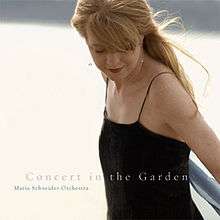Concert in the Garden
| Concert in the Garden | ||||
|---|---|---|---|---|
 | ||||
| Studio album by Maria Schneider | ||||
| Released | 2004 | |||
| Recorded | 8–11 March 2004 | |||
| Studio | Avatar Studios in New York City | |||
| Genre | Jazz | |||
| Label | ArtistShare | |||
| Producer | Maria Schneider | |||
| Maria Schneider chronology | ||||
| ||||
| Professional ratings | |
|---|---|
| Review scores | |
| Source | Rating |
| Allmusic | |
| The Penguin Guide to Jazz | |
Concert in the Garden is the fourth studio album by American jazz composer, Maria Schneider. The album was released in 2004 through ArtistShare and won the 2005 Grammy Award for "Best Large Ensemble Album".
Background
Schneider's three previous albums were nominated for Grammy Awards, but the previous one, Allegresse, was released four years before Concert in the Garden. The delay has been attributed to the financial difficulty of recording with large groups, which are required for the music that Schneider writes.[3]
Music
The compositions on Schneider's album are "more influenced by Spanish, flamenco and Brazilian forms than any of her previous works". "Choro Dançado" contains interwoven formal motives, leading to a tenor saxophone solo by Rich Perry. "Pas de Deux" builds slowly in intensity, increasing in volume when Ingrid Jensen's flugelhorn and Charles Pillow's soprano saxophone join in. "Dança Ilusória" consists of a "through-composed line, with jewel-like solos embedded in it from Frank Kimbrough and trombonist Larry Farrell". "Buleria, Soleá y Rumba" also begins quietly, with the tenor saxophone of Donny McCaslin appearing over the orchestra and gradually pulling it along.[3]
Reception
The Jazz Times review was largely positive, commenting that "Three Romances" and "Buleria, Solea y Rumba" "are revelatory in their complete realization", but that the solos on the other piece "are not strong enough to provide sufficient contrast to the piece's slow, hovering progress".[3]
The Penguin Guide to Jazz gave it a maximum four stars and included it in its recommended Core Collection. It also stated that "Concert in the Garden" was a weakness, but that overall the album was "the great achievement of her career so far".[2]
Track listing
- "Concert in the Garden" – 11:57
- "Three Romances: Choro Dançado" – 9:45
- "Three Romances: Pas de Deux" – 9:02
- "Three Romances: Dança Ilusória" – 9:05
- "Bulería, Soleá y Rumba" – 18:24
Personnel
- Tim Ries – alto saxophone, soprano saxophone, clarinet, flute, alto flute, bass flute
- Charles Pillow – alto saxophone, soprano saxophone, clarinet, flute, alto flute, oboe, English horn
- Rich Perry – tenor saxophone, flute
- Donny McCaslin – tenor saxophone, soprano saxophone, clarinet, flute
- Scott Robinson – baritone saxophone, flute, clarinet, bass clarinet, contrabass clarinet
- Tony Kadleck – trumpet, flügelhorn
- Greg Gisbert – trumpet, flügelhorn
- Laurie Frink – trumpet, flügelhorn
- Ingrid Jensen – trumpet, flügelhorn
- Keith O’Quinn – trombone
- Rock Ciccarone – trombone
- Larry Farrell – trombone
- George Flynn – bass trombone, contrabass trombone
- Ben Monder – guitar
- Frank Kimbrough – piano
- Jay Anderson – bass
- Clarence Penn – drums
- Jeff Ballard – cajón and quinto cajón on "Bulería, Soleá y Rumba" (stereo right)
- Gonzalo Grau – cajón on "Bulería, Soleá y Rumba" (stereo left)
- Gary Versace – accordion on "Concert in the Garden"
- Luciana Souza – voice on "Concert in the Garden" and "Bulería, Soleá y Rumba". Voice and pandeiro on "Choro Dançado"
- Pete McGuinness – trombone on "Pas de Deux" and "Dança Ilusória"
- Andy Middleton – tenor saxophone on "Pas de Deux" and "Dança Ilusória"
References
- ↑ Allmusic review
- 1 2 Cook, Richard and Morton, Brian (2008) The Penguin Guide to Jazz Recordings (9th ed.) Penguin, pp. 1268-9.
- 1 2 3 Conrad, Thomas (October 2004) "Maria Schneider Orchestra: Concert in the Garden" Jazz Times.